Labyrinth Enterprises
1995-2022
1995
Founded by me, Robert Ferre, as The St. Louis Labyrinth Project. Thus began a decades-long association with Veriditas for whom I made canvas labyrinths for 15 years, taught labyrinth classes, and led two pilgrimages.

1996-1997
Organized two tours for Veriditas to Chartres and pilgrimage sites in France and Germany. The group organized an effort to bring the rector of Chartres Cathedral, François Legaux, to Grace Cathedral in San Francisco, leading to a close relationship between the two churches and opening the labyrinth in Chartres for public use. (I used to have a little more hair in those days.)
In clerical garb, left, the Rev. Dr. Lauren Artress, founder of Veriditas and honorary canon of Grace Cathedral in San Francisco, and right, François Legaux, Rector and Dean of Chartres Cathedral (at that time), Chartres, France.
Veriditas group in Amiens Cathedral (Lauren Artress is across the circle in the pink sweater).
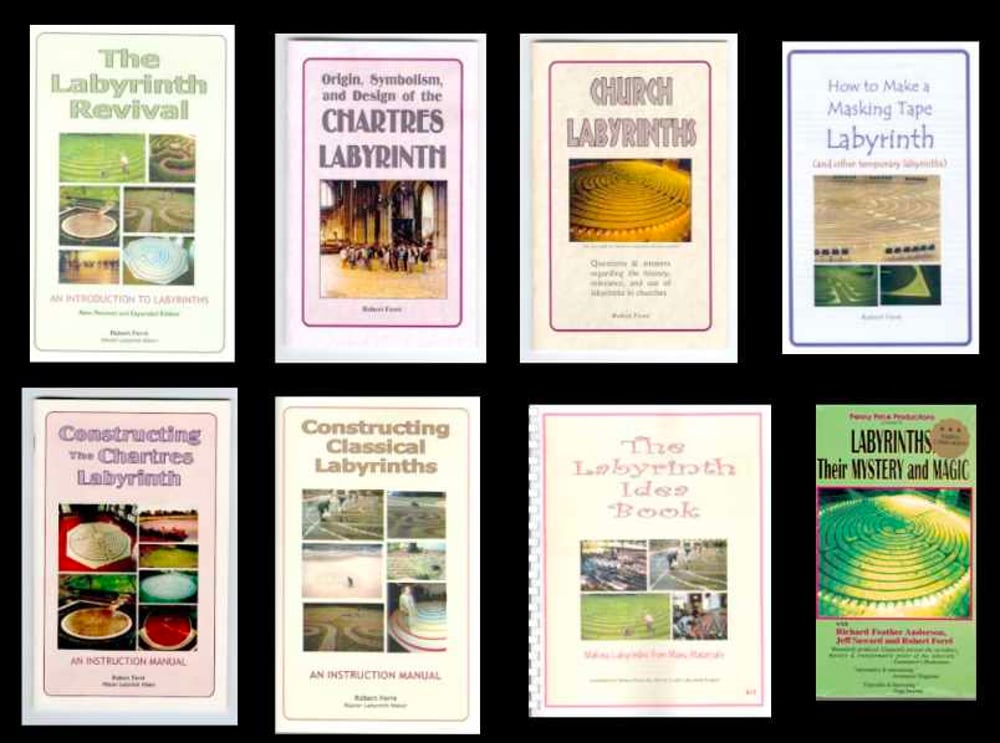
1997
Invented techniques for making portable and permanent labyrinths. Wrote the first manuals on labyrinth construction, which were updated and expanded a decade later.
Judy Hopen joined the company and proved to be extraordinary at precisely drawing and painting canvas labyrinths as well as participating in onsite installations.

Judy working at the painting table, doing a large canvas in three-foot increments.
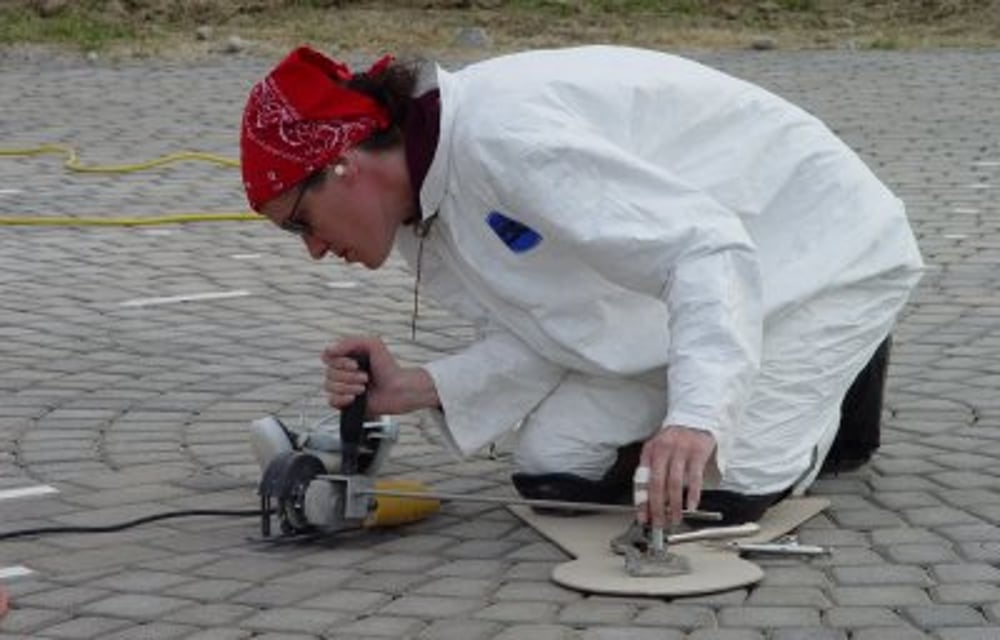
Judy scoring the labrys turns on pavers, later to be colored.
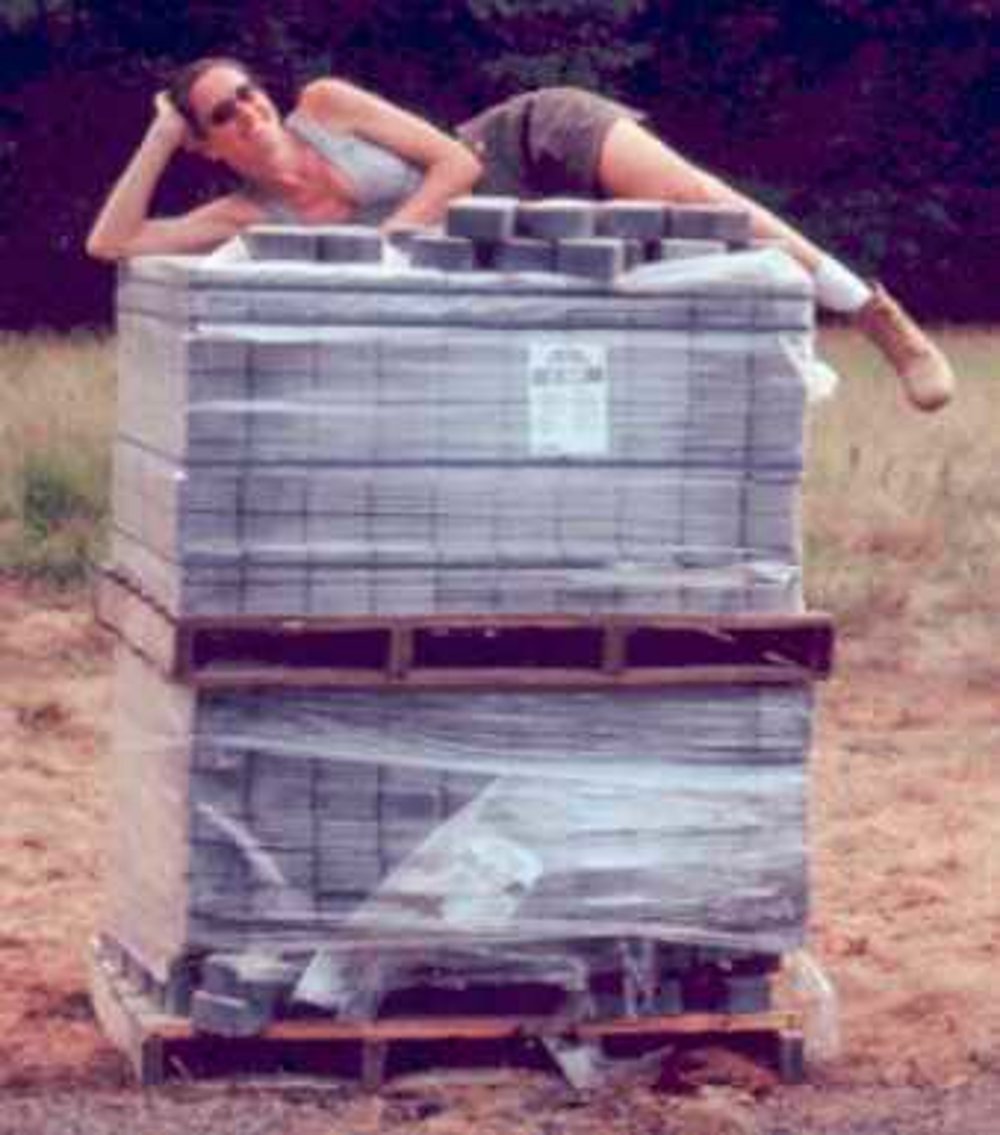
Judy taking a rest. Then she carried all of those pavers into the labyrinth. She moonlighted as a photographer's model.
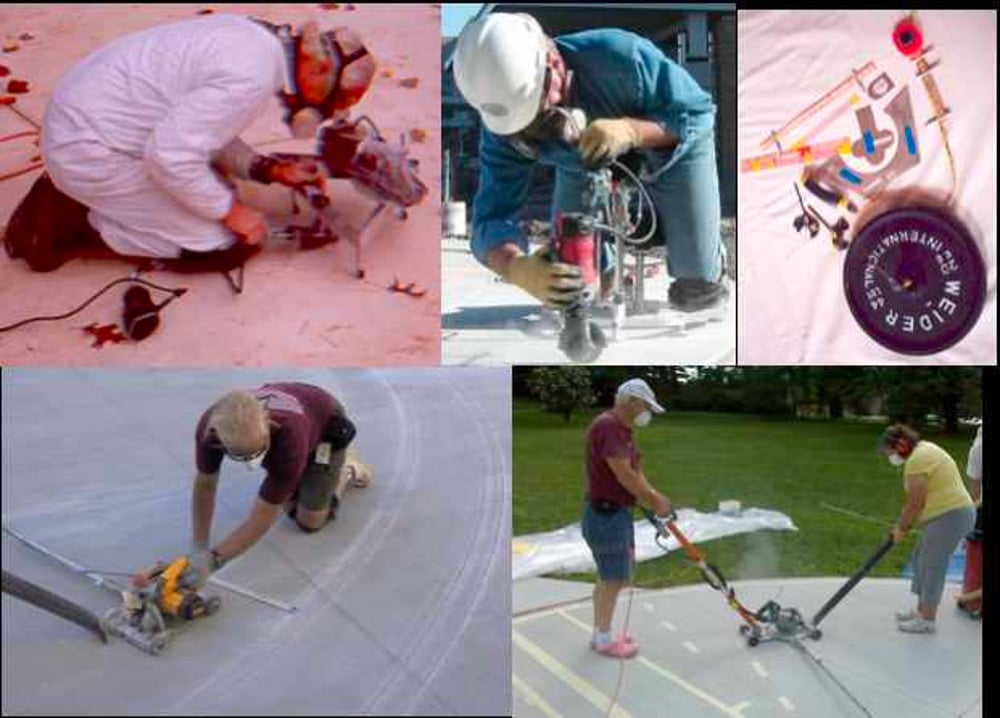
Many colleagues helped in building labyrinths on an as-needed basis. I custom-made most of our labyrinth templates and tools, some of which are shown above.
1997-1998
Organized meetings in St. Louis, MO, leading to the founding of The Labyrinth Society (see links section).
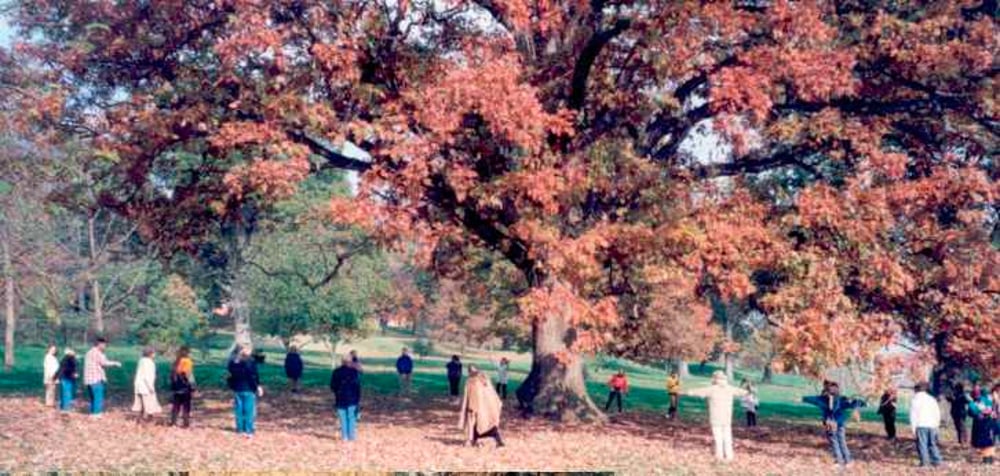
Our second meeting (1998) during which we formed the Labyrinth Society. I take credit for suggesting the name. It sounded classy to me.
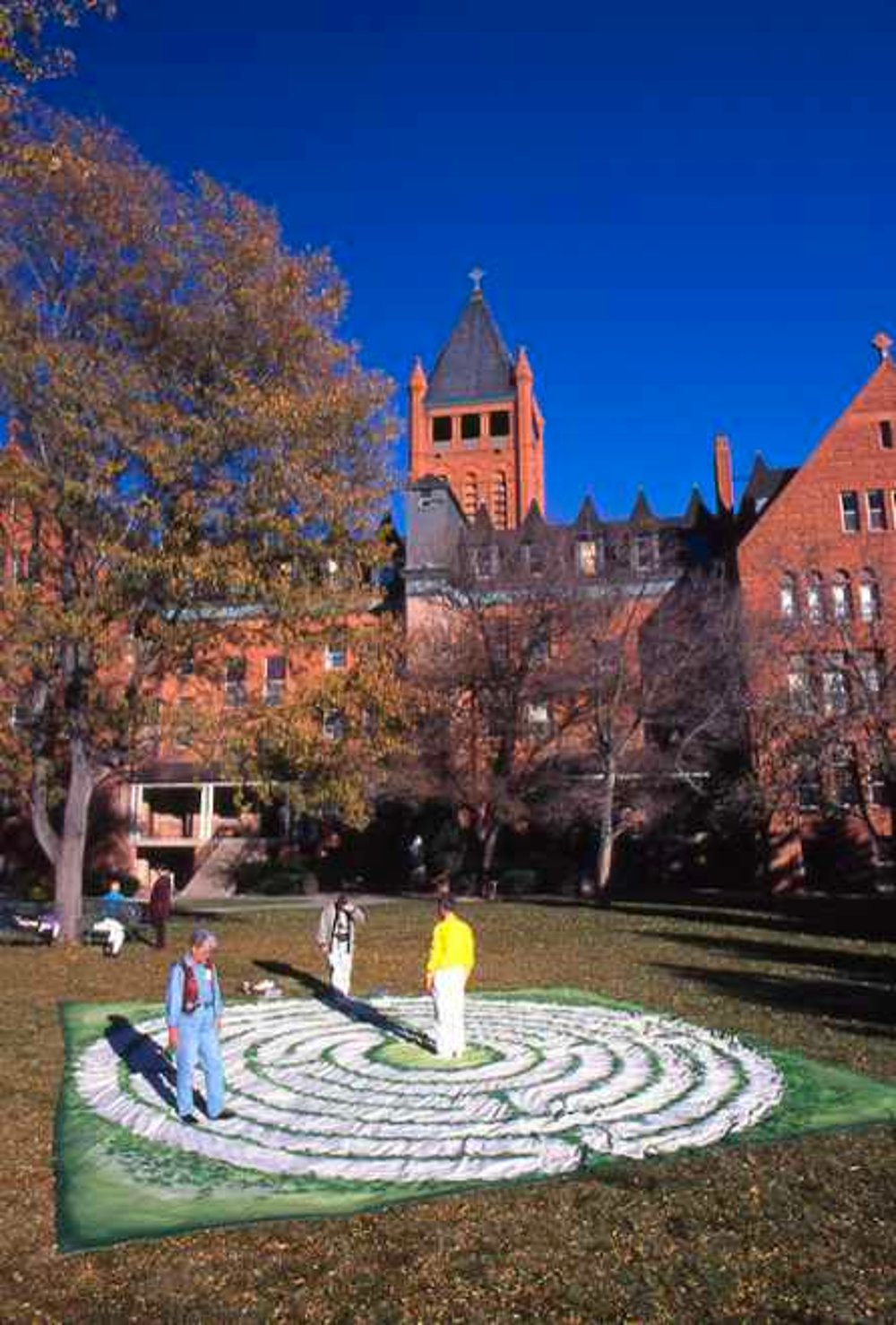
1999
The first annual gathering of The Labyrinth Society was held at Teikyo Loretto Heights University in Denver, CO. In 2018 the campus was closed and sold a year later to a real estate developer.
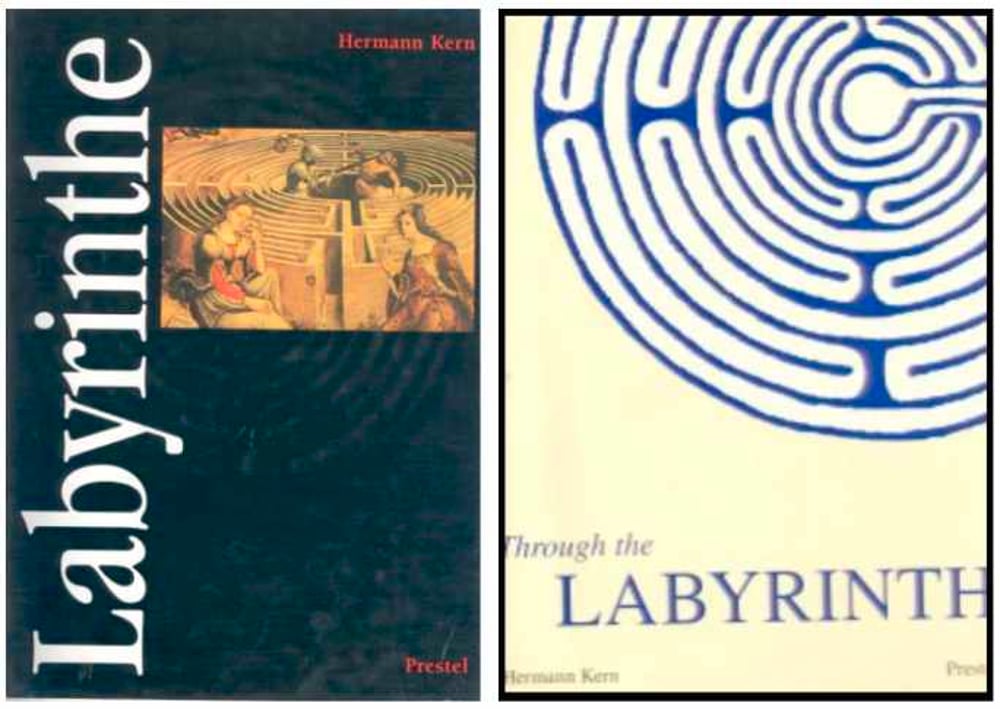
2000
Co-edited (with Jeff Saward) the English version of Through the Labyrinth: Designs and Meanings over 5000 Years (from the German edition by Hermann Kern, published by Prestel). (Now out of print. If you find a used one, snap it up.)
2003
Changed the company name to Labyrinth Enterprises at the suggestion of my then wife Ruth Hanna. The definition of “enterprise” includes:
1. An undertaking, especially one of great scope and complication
2. Systematic and industrious activity
3. Eagerness to venture
4. To boldly go where no labyrinth has gone before.
(Okay, I made that one up.)
5. Readiness to try something untried
6. Energy and initiative
7. The carrying on of projects
8. A business organization
We traveled coast to coast making labyrinths of all kinds.
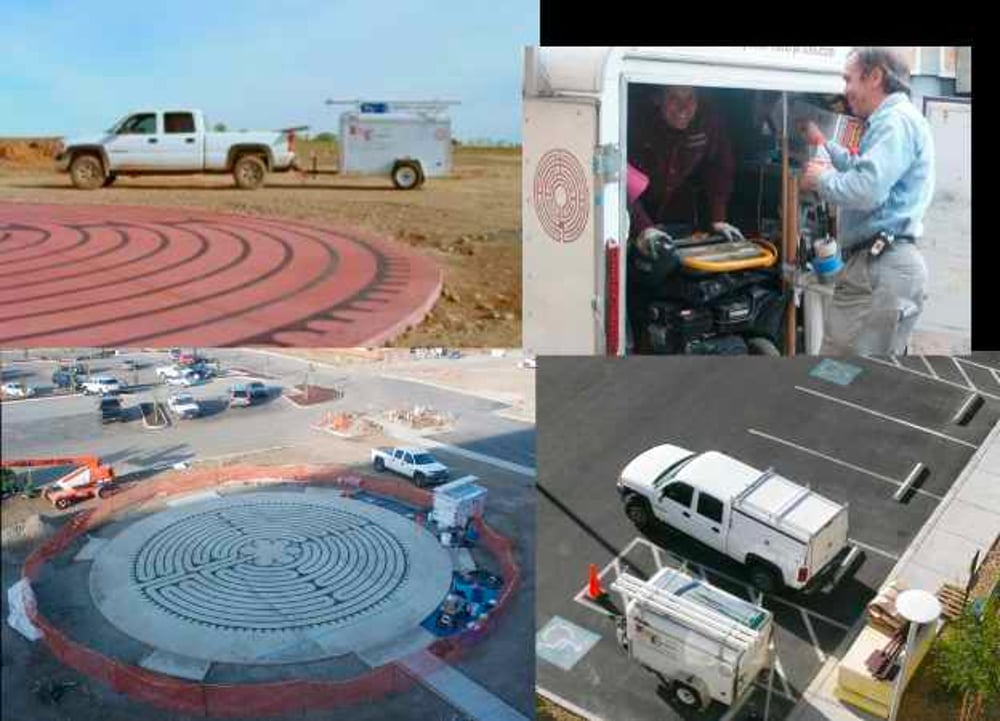
Labyrinth installations
Top left: Our Lady of Victory Hospital, Stanley,Wisconsin
Top right: Onsite supervisor Chuck Hunner
Lower left: Kaiser Permanente Antioch Medical Center, Antioch, California
Lower right: San Martin Hospital parking lot, Las Vegas.
The coloring medium in these installations was polymer concrete, which we mixed onsite in small batches.
2005
Making labyrinths required a large work space.
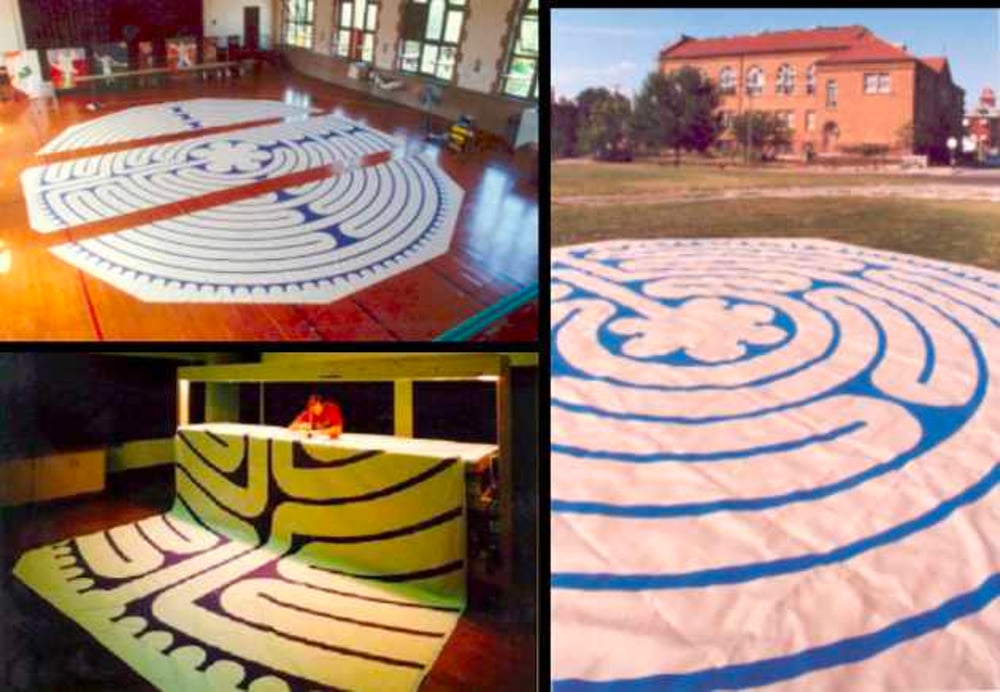
Our first studio included a classroom at Taproots School of the Arts in St. Louis, plus shared use of the gymnasium. Whenever there was an event we had to put all of our tools away. We don't recommend putting canvas labyrinths outside on the ground. This was for photographic purposes only.
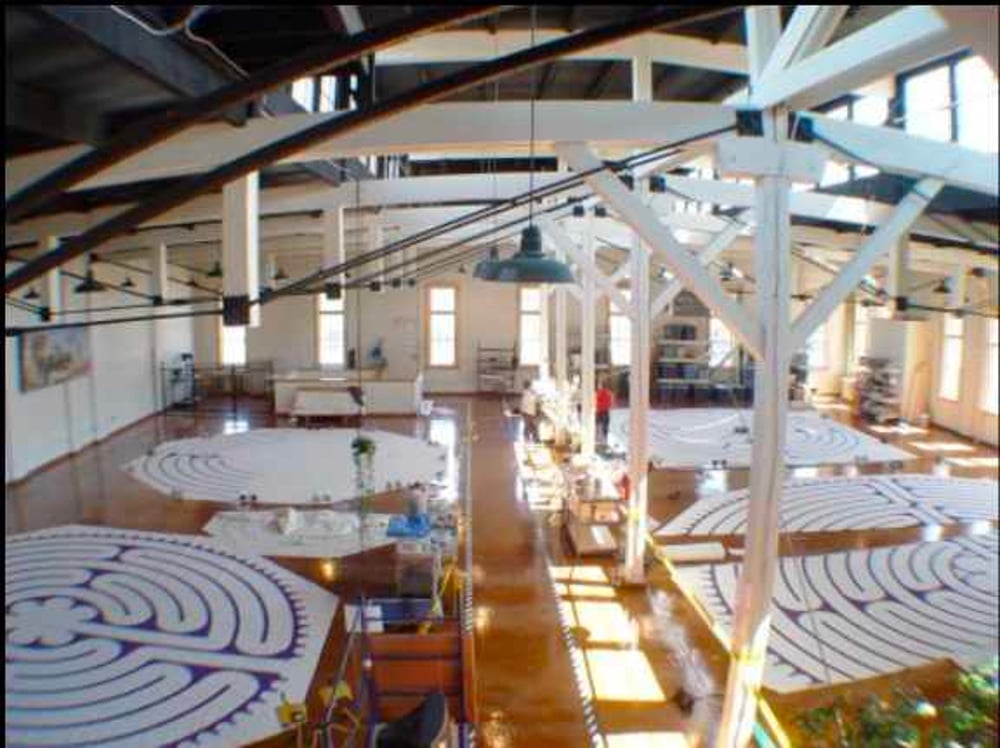
Opened our very own 8,000 sq. ft. studio with high ceilings and lots of light.
2008
Introduced crushed granite overlay as the most desirable material for placing labyrinth patterns onto concrete surfaces. This soon replaced polymer concrete as our material of choice because it comes premixed, is easier to use, and is more uniform and presentable.
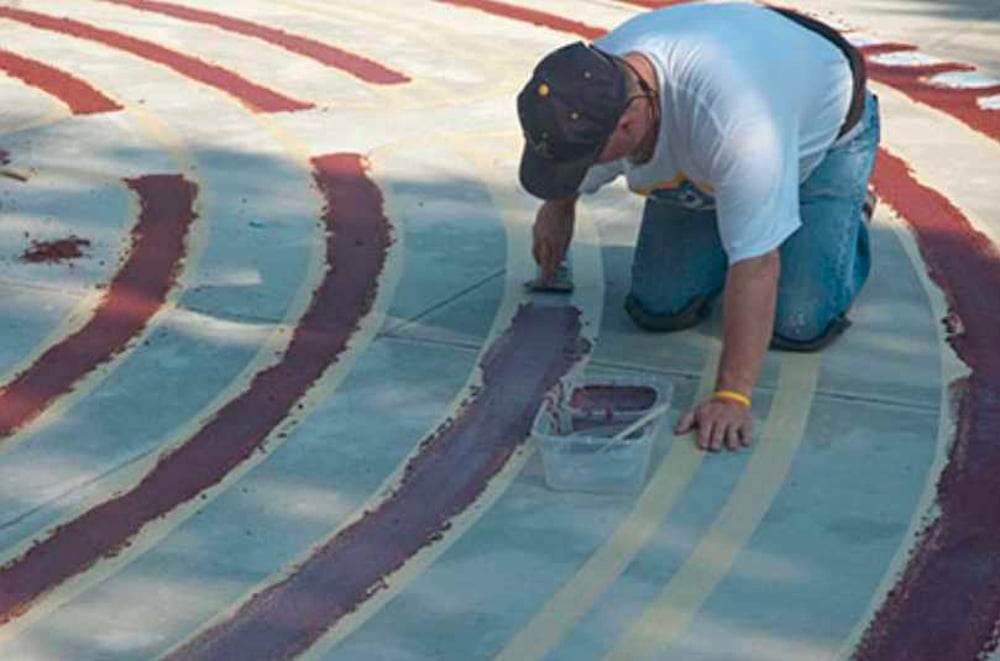
The crushed granite is in an acrylic base that changes color as it dries and the acrylic becomes clear. We had superb tools for laying out the masking tape circles.

Here is another example of crushed granite overlay. This labyrinth is in a prison in Pueblo, Colorado. Three prisoners helped us make it.
2010
Conducted a master class on labyrinth building at Grace Cathedral in San Francisco. In attendance was Lars Howlett, who subsequently became my apprentice for four years.
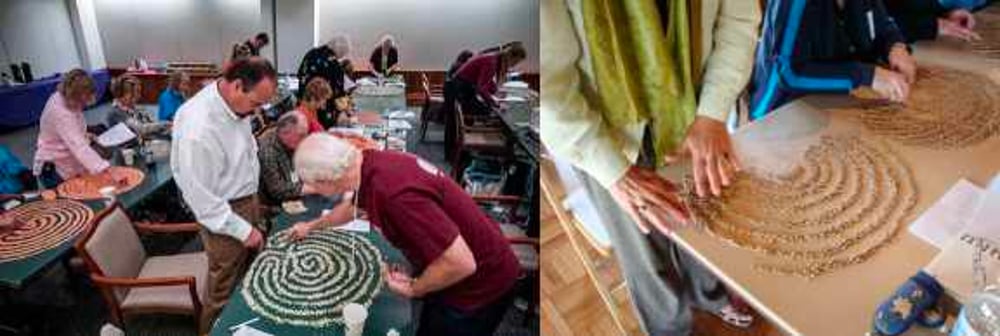
Above: Labyrinth masterclass for Veriditas (at the Presidio in San Francisco), making tabletop labyrinths from beans.

Closed the studio in St. Louis and moved to San Antonio, TX, to marry Linda Ricketts, who developed into a skillful labyrinth worker (above). For more about Linda (and me) see: BIO.
2012
Judy Hopen, the soul of Labyrinth Enterprises, dies of breast cancer at age 52. Judy hand drew and painted more labyrinths (800+) than anyone in history.

Ever a fashionista, Judy with her henna tattoos.
2012-2015
Lars Howlett became my apprentice for four years. Together we made labyrinths and co-led trainings for Veriditas which came to be called Labyrinth Summer School. In subsequent years, I dropped out and Lars continued, often with guest presenters. Can you figure out which one is Lars?
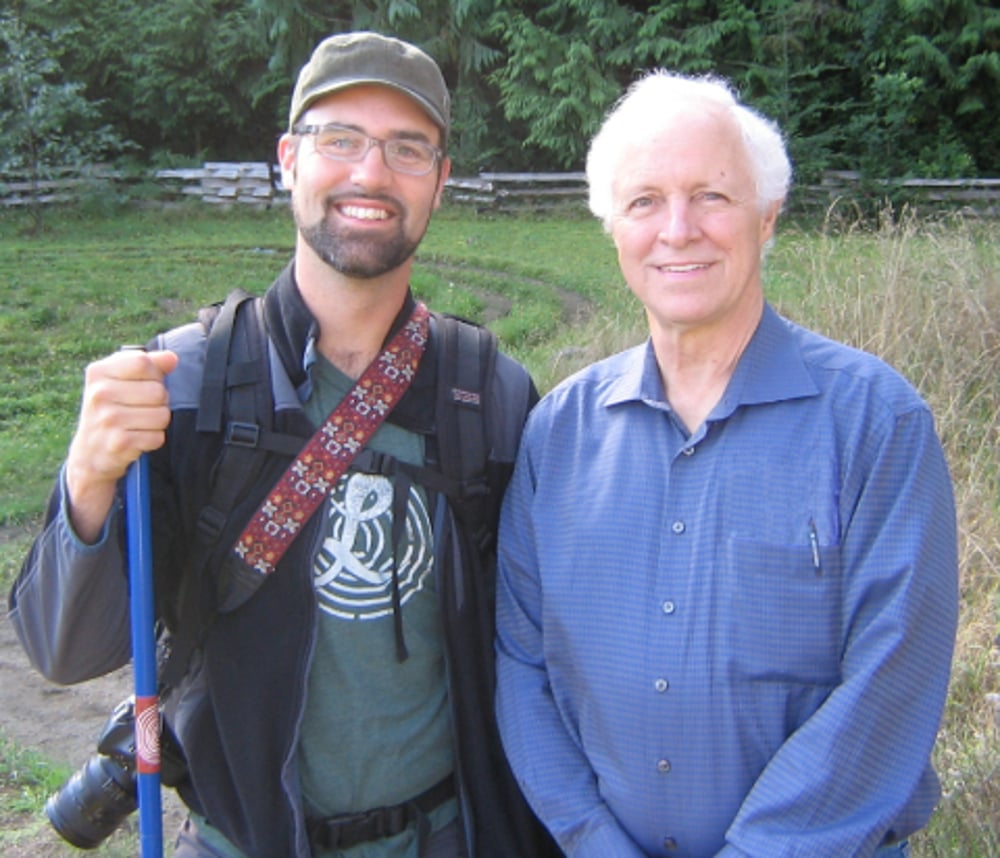
2015-present
Lars founded his own labyrinth company called Discover Labyrinths (see www.discoverlabyrinths.com). He became a faculty member for Veriditas in 2016, an advanced Facilitator in 2019, and joined the staff in 2021. For all intents and purposes, Discover Labyrinths has carried on the work of Labyrinth Enterprises, taking it to even greater heights and achievement. (See links section.)
2016
I published The Labyrinth Revival: A Personal Account, outlining the history of the labyrinth movement in the United States. All of my labyrinth books are being given to Lars Howlett for updating, expansion, and future re-publication. (He also has my tools and library.)
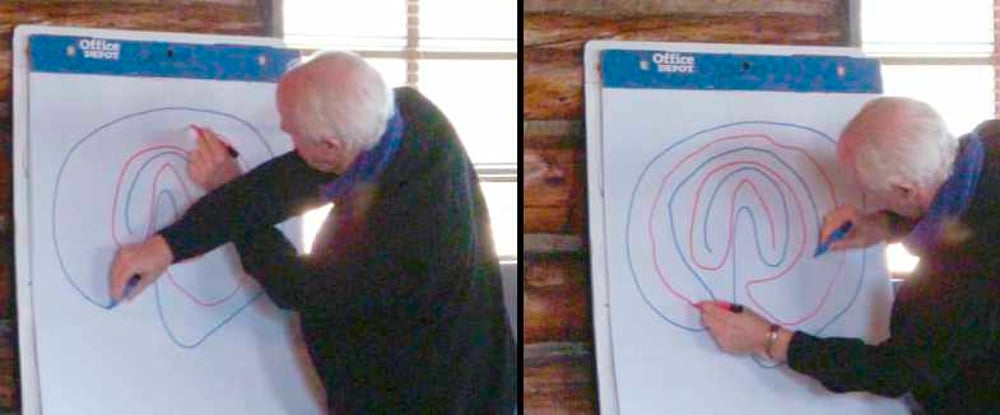
The classical 7-circuit labyrinth pattern consists of two intersecting lines. Here, I am drawing both lines simultaneously, using both hands. Granted, it needs a bit more practice.
2018
I attended the 20th anniversary of the labyrinth some volunteers and I made at the Mercy Center in St. Louis in 1998. Back then, it was in the middle of a barren field with a tiny sapling planted in the center and others around the perimeter. What a difference 20 years of loving care and use can make.
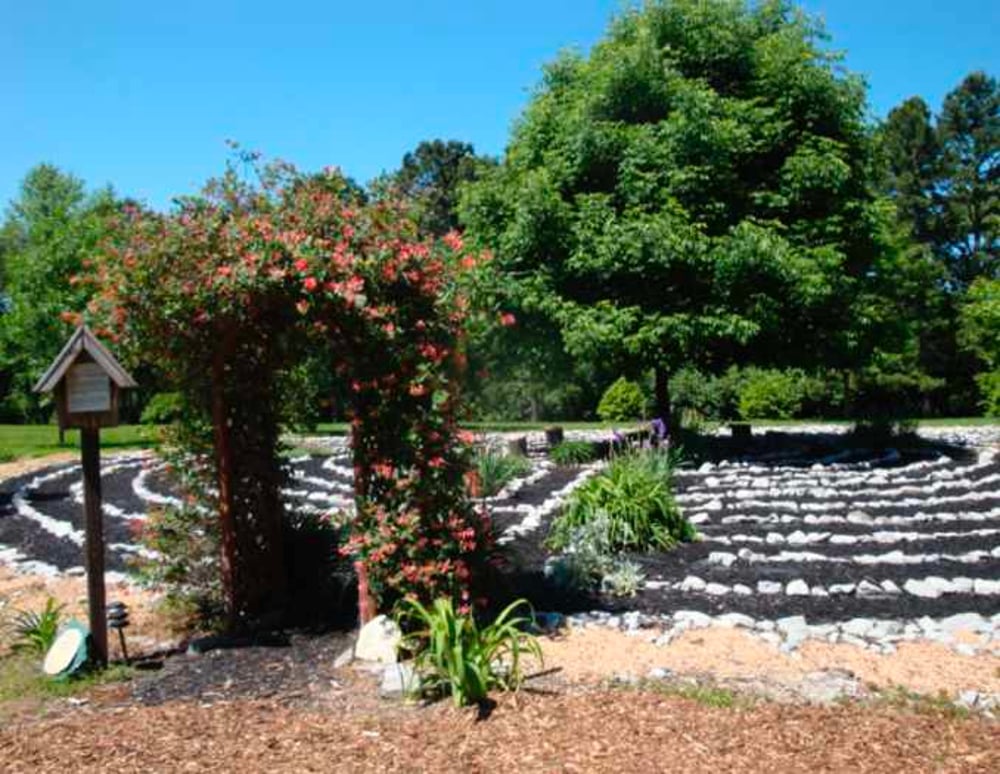
The Mercy Center labyrinth has rubber tire mulch, which contrasts nicely with the white stones.
2022
While mostly retired, I still do some design and consulting work and supervise a labyrinth installation now and then. Below are a few more bonus photographs of interest.
Return to Home Page
See labyrinth links.
Contact me: robert@robertferre.com
Polymer concrete labyrinth, Livermore, California.
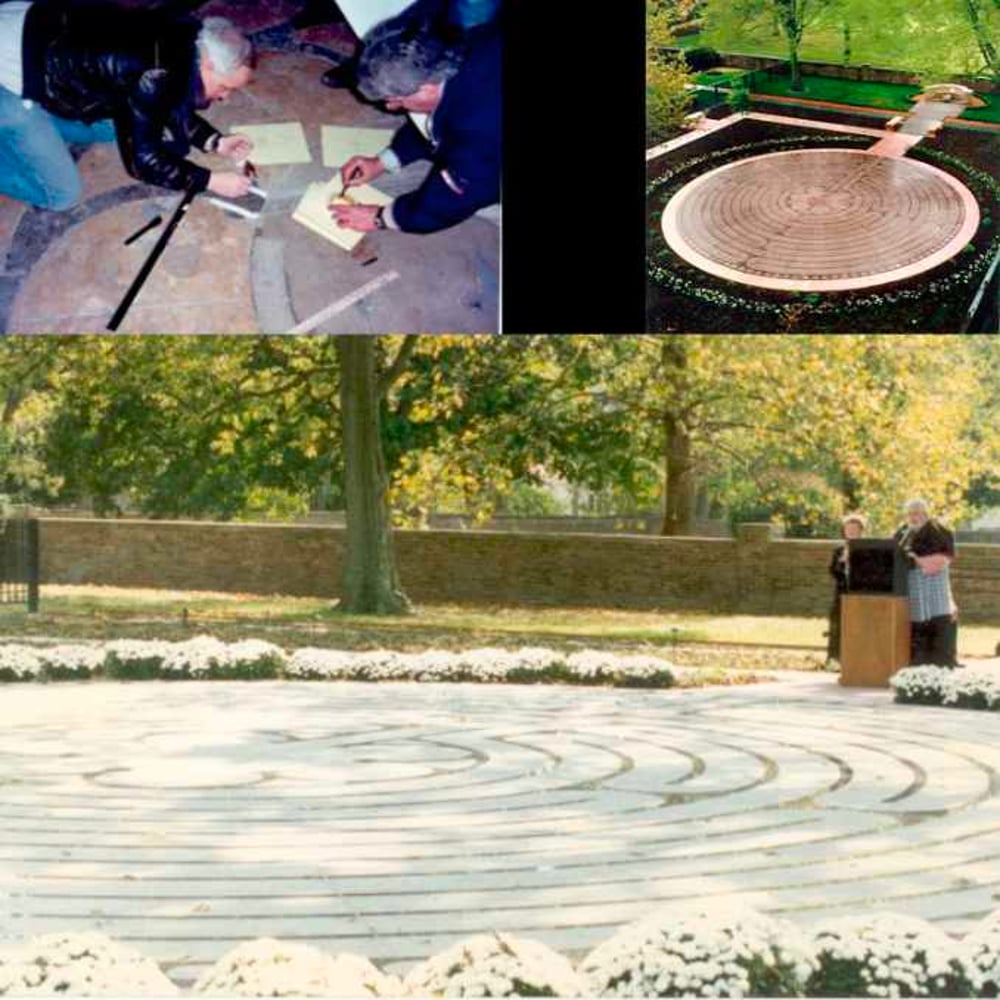
The Cathedral Labyrinth in New Harmony, Indiana.
Above left: Me and architect Rob Sovinsky in Chartres Cathedral, France, measuring the labyrinth. Above right: The labyrinth and the fountain, where you can wash your feet before or after walking. Bottom photo: The Rector of Chartres Cathedral (and translator) at the dedication of the labyrinth in 1998. All of this was possible through the provenance of Jane Blaffer Owen.
Here I am hand painting the veins in each of the 3,000 leaves comprising the ivy canvas labyrinth (Santa Rosa design). Whew! I said I would never do that again, but I did.

The trials and tribulations of a labyrinth maker.
Upper left, scraping off the snow from an overnight snowstorm at the First Presbyterian Church in Danville, KY. That’s Chuck Hunner with me, braving the sub-freezing temperatures. See his jewelry and labyrinth work at www.goldenspirit.com.
Upper right: Stuck in the mud in Stanley, WI, making a labyrinth for Our Lady of Victory Hospital. First, dust was the problem. Then it rained.
Lower: Working on crutches at St. Benedict Episcopal Church in Honolulu, HI. Space was so limited that we installed the labyrinth on the parking lot. So, the only time the church people can walk it is when they aren’t there. Figure that one out.
Our crew having dinner in Honolulu. I decided early on that labyrinth builders should eat well. Left to right: David Ferré (brother), Kathy Childs (David’s wife), Judy Hopen (my assistant), and me.
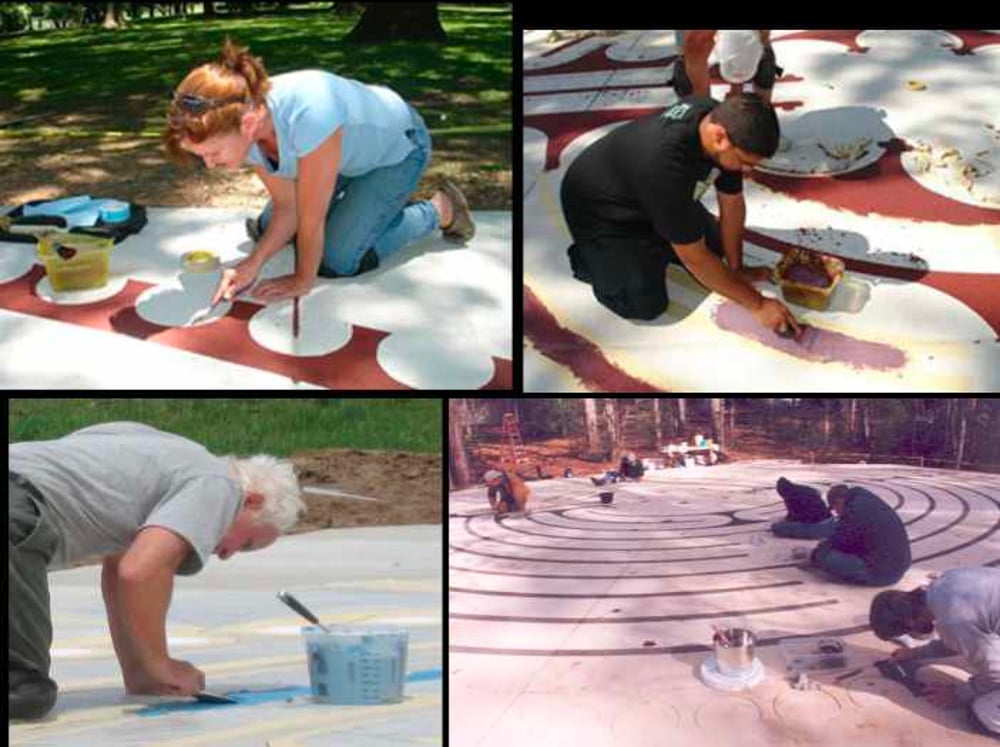
Many thanks to the hundreds of volunteers who helped make labyrinths over two and one-half decades. Okay, that’s me on the lower left and I was not a volunteer, but thanks to all the others, ranging in age from four to 84.
HOME PAGE
LINKS PAGE